University Report: Effective Communication in Health and Social Care
VerifiedAdded on 2023/06/05
|11
|3320
|371
Report
AI Summary
This report provides a comprehensive overview of effective communication within health and social care settings. It begins by highlighting the significance of clear communication in fostering positive relationships and delivering quality care. The report explores the communication preferences of individuals, emphasizing the importance of adapting methods to meet diverse needs. It delves into potential barriers to effective communication, such as dissatisfaction, lack of transparency, and differing communication styles, and offers practical strategies for overcoming these challenges. Additionally, the report examines the importance of accessing support services, including translation and advocacy, to ensure effective communication. Finally, it addresses the crucial concepts of equality, diversity, and inclusion within health and social care, underscoring their role in creating a supportive and respectful environment for all individuals.
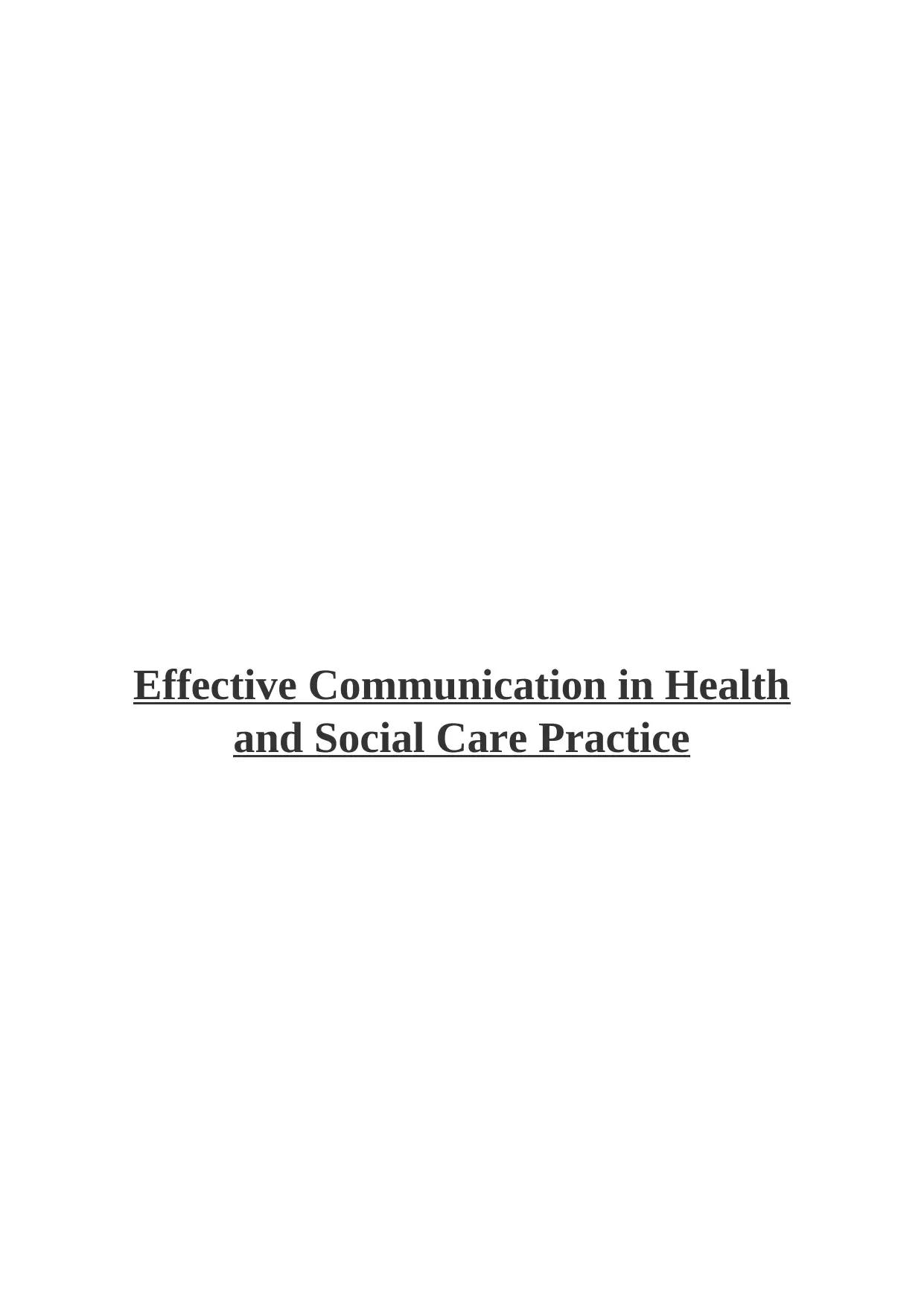
Effective Communication in Health
and Social Care Practice
and Social Care Practice
Paraphrase This Document
Need a fresh take? Get an instant paraphrase of this document with our AI Paraphraser

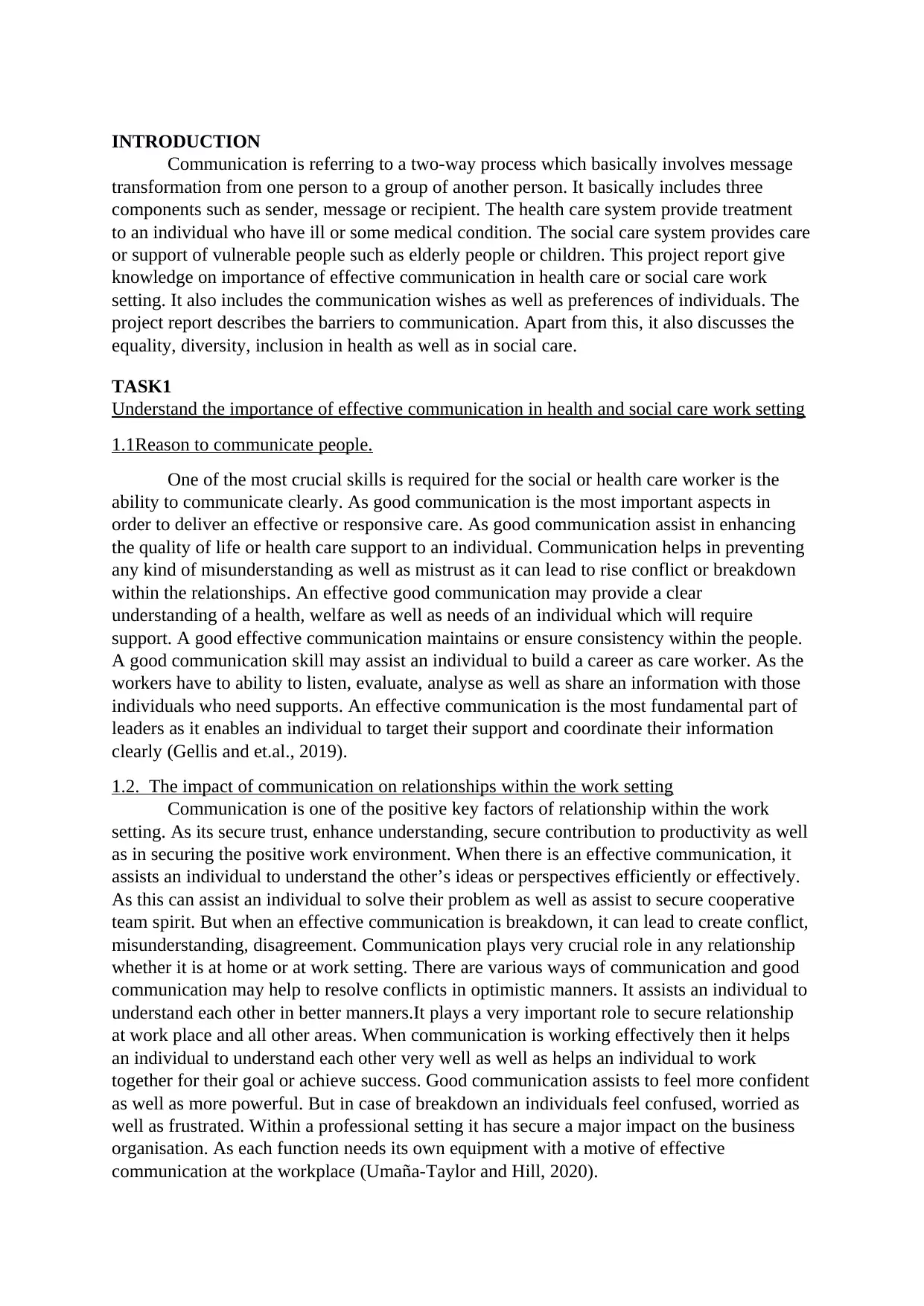
INTRODUCTION
Communication is referring to a two-way process which basically involves message
transformation from one person to a group of another person. It basically includes three
components such as sender, message or recipient. The health care system provide treatment
to an individual who have ill or some medical condition. The social care system provides care
or support of vulnerable people such as elderly people or children. This project report give
knowledge on importance of effective communication in health care or social care work
setting. It also includes the communication wishes as well as preferences of individuals. The
project report describes the barriers to communication. Apart from this, it also discusses the
equality, diversity, inclusion in health as well as in social care.
TASK1
Understand the importance of effective communication in health and social care work setting
1.1Reason to communicate people.
One of the most crucial skills is required for the social or health care worker is the
ability to communicate clearly. As good communication is the most important aspects in
order to deliver an effective or responsive care. As good communication assist in enhancing
the quality of life or health care support to an individual. Communication helps in preventing
any kind of misunderstanding as well as mistrust as it can lead to rise conflict or breakdown
within the relationships. An effective good communication may provide a clear
understanding of a health, welfare as well as needs of an individual which will require
support. A good effective communication maintains or ensure consistency within the people.
A good communication skill may assist an individual to build a career as care worker. As the
workers have to ability to listen, evaluate, analyse as well as share an information with those
individuals who need supports. An effective communication is the most fundamental part of
leaders as it enables an individual to target their support and coordinate their information
clearly (Gellis and et.al., 2019).
1.2. The impact of communication on relationships within the work setting
Communication is one of the positive key factors of relationship within the work
setting. As its secure trust, enhance understanding, secure contribution to productivity as well
as in securing the positive work environment. When there is an effective communication, it
assists an individual to understand the other’s ideas or perspectives efficiently or effectively.
As this can assist an individual to solve their problem as well as assist to secure cooperative
team spirit. But when an effective communication is breakdown, it can lead to create conflict,
misunderstanding, disagreement. Communication plays very crucial role in any relationship
whether it is at home or at work setting. There are various ways of communication and good
communication may help to resolve conflicts in optimistic manners. It assists an individual to
understand each other in better manners.It plays a very important role to secure relationship
at work place and all other areas. When communication is working effectively then it helps
an individual to understand each other very well as well as helps an individual to work
together for their goal or achieve success. Good communication assists to feel more confident
as well as more powerful. But in case of breakdown an individuals feel confused, worried as
well as frustrated. Within a professional setting it has secure a major impact on the business
organisation. As each function needs its own equipment with a motive of effective
communication at the workplace (Umaña‐Taylor and Hill, 2020).
Communication is referring to a two-way process which basically involves message
transformation from one person to a group of another person. It basically includes three
components such as sender, message or recipient. The health care system provide treatment
to an individual who have ill or some medical condition. The social care system provides care
or support of vulnerable people such as elderly people or children. This project report give
knowledge on importance of effective communication in health care or social care work
setting. It also includes the communication wishes as well as preferences of individuals. The
project report describes the barriers to communication. Apart from this, it also discusses the
equality, diversity, inclusion in health as well as in social care.
TASK1
Understand the importance of effective communication in health and social care work setting
1.1Reason to communicate people.
One of the most crucial skills is required for the social or health care worker is the
ability to communicate clearly. As good communication is the most important aspects in
order to deliver an effective or responsive care. As good communication assist in enhancing
the quality of life or health care support to an individual. Communication helps in preventing
any kind of misunderstanding as well as mistrust as it can lead to rise conflict or breakdown
within the relationships. An effective good communication may provide a clear
understanding of a health, welfare as well as needs of an individual which will require
support. A good effective communication maintains or ensure consistency within the people.
A good communication skill may assist an individual to build a career as care worker. As the
workers have to ability to listen, evaluate, analyse as well as share an information with those
individuals who need supports. An effective communication is the most fundamental part of
leaders as it enables an individual to target their support and coordinate their information
clearly (Gellis and et.al., 2019).
1.2. The impact of communication on relationships within the work setting
Communication is one of the positive key factors of relationship within the work
setting. As its secure trust, enhance understanding, secure contribution to productivity as well
as in securing the positive work environment. When there is an effective communication, it
assists an individual to understand the other’s ideas or perspectives efficiently or effectively.
As this can assist an individual to solve their problem as well as assist to secure cooperative
team spirit. But when an effective communication is breakdown, it can lead to create conflict,
misunderstanding, disagreement. Communication plays very crucial role in any relationship
whether it is at home or at work setting. There are various ways of communication and good
communication may help to resolve conflicts in optimistic manners. It assists an individual to
understand each other in better manners.It plays a very important role to secure relationship
at work place and all other areas. When communication is working effectively then it helps
an individual to understand each other very well as well as helps an individual to work
together for their goal or achieve success. Good communication assists to feel more confident
as well as more powerful. But in case of breakdown an individuals feel confused, worried as
well as frustrated. Within a professional setting it has secure a major impact on the business
organisation. As each function needs its own equipment with a motive of effective
communication at the workplace (Umaña‐Taylor and Hill, 2020).
⊘ This is a preview!⊘
Do you want full access?
Subscribe today to unlock all pages.

Trusted by 1+ million students worldwide
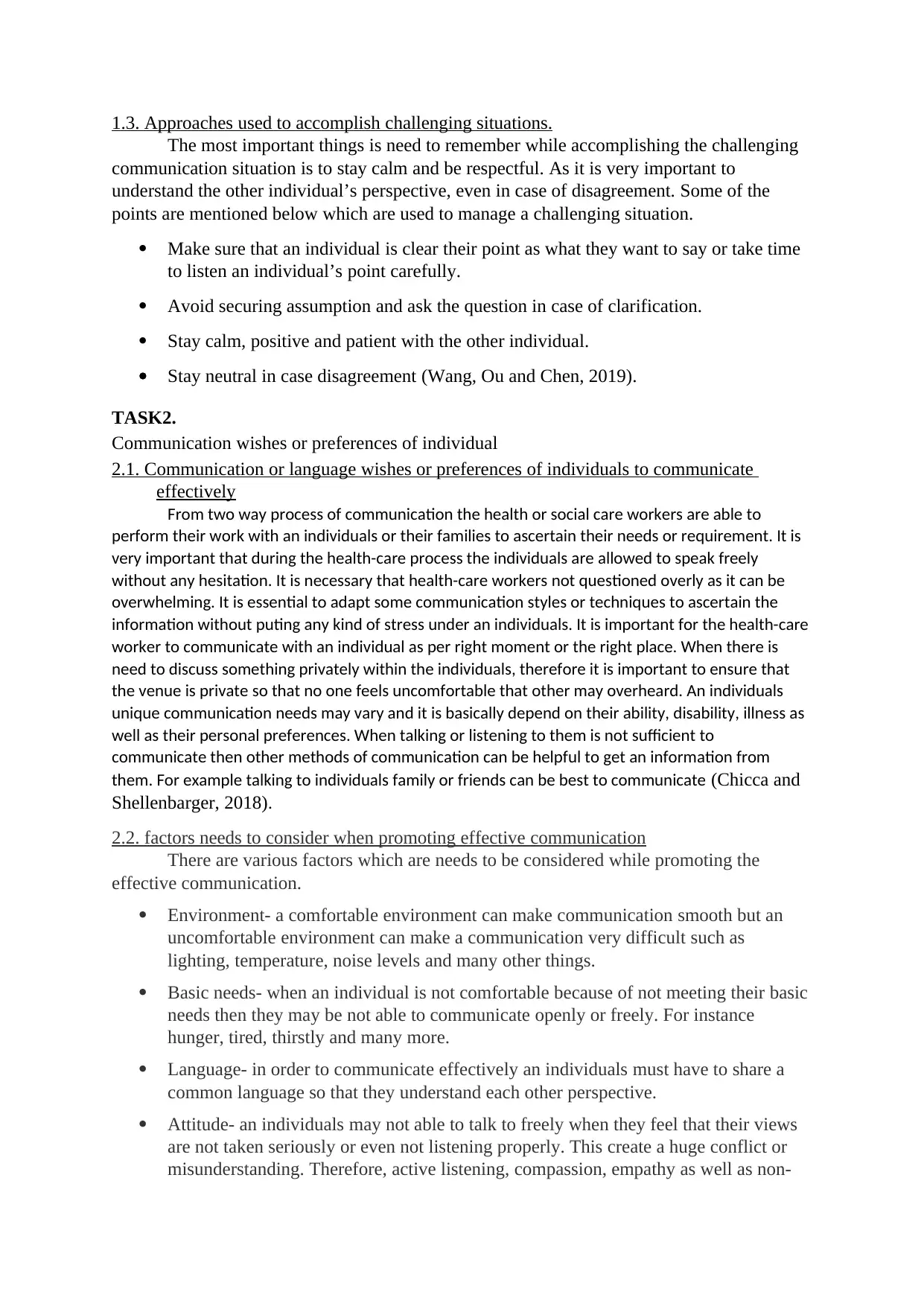
1.3. Approaches used to accomplish challenging situations.
The most important things is need to remember while accomplishing the challenging
communication situation is to stay calm and be respectful. As it is very important to
understand the other individual’s perspective, even in case of disagreement. Some of the
points are mentioned below which are used to manage a challenging situation.
Make sure that an individual is clear their point as what they want to say or take time
to listen an individual’s point carefully.
Avoid securing assumption and ask the question in case of clarification.
Stay calm, positive and patient with the other individual.
Stay neutral in case disagreement (Wang, Ou and Chen, 2019).
TASK2.
Communication wishes or preferences of individual
2.1. Communication or language wishes or preferences of individuals to communicate
effectively
From two way process of communication the health or social care workers are able to
perform their work with an individuals or their families to ascertain their needs or requirement. It is
very important that during the health-care process the individuals are allowed to speak freely
without any hesitation. It is necessary that health-care workers not questioned overly as it can be
overwhelming. It is essential to adapt some communication styles or techniques to ascertain the
information without puting any kind of stress under an individuals. It is important for the health-care
worker to communicate with an individual as per right moment or the right place. When there is
need to discuss something privately within the individuals, therefore it is important to ensure that
the venue is private so that no one feels uncomfortable that other may overheard. An individuals
unique communication needs may vary and it is basically depend on their ability, disability, illness as
well as their personal preferences. When talking or listening to them is not sufficient to
communicate then other methods of communication can be helpful to get an information from
them. For example talking to individuals family or friends can be best to communicate (Chicca and
Shellenbarger, 2018).
2.2. factors needs to consider when promoting effective communication
There are various factors which are needs to be considered while promoting the
effective communication.
Environment- a comfortable environment can make communication smooth but an
uncomfortable environment can make a communication very difficult such as
lighting, temperature, noise levels and many other things.
Basic needs- when an individual is not comfortable because of not meeting their basic
needs then they may be not able to communicate openly or freely. For instance
hunger, tired, thirstly and many more.
Language- in order to communicate effectively an individuals must have to share a
common language so that they understand each other perspective.
Attitude- an individuals may not able to talk to freely when they feel that their views
are not taken seriously or even not listening properly. This create a huge conflict or
misunderstanding. Therefore, active listening, compassion, empathy as well as non-
The most important things is need to remember while accomplishing the challenging
communication situation is to stay calm and be respectful. As it is very important to
understand the other individual’s perspective, even in case of disagreement. Some of the
points are mentioned below which are used to manage a challenging situation.
Make sure that an individual is clear their point as what they want to say or take time
to listen an individual’s point carefully.
Avoid securing assumption and ask the question in case of clarification.
Stay calm, positive and patient with the other individual.
Stay neutral in case disagreement (Wang, Ou and Chen, 2019).
TASK2.
Communication wishes or preferences of individual
2.1. Communication or language wishes or preferences of individuals to communicate
effectively
From two way process of communication the health or social care workers are able to
perform their work with an individuals or their families to ascertain their needs or requirement. It is
very important that during the health-care process the individuals are allowed to speak freely
without any hesitation. It is necessary that health-care workers not questioned overly as it can be
overwhelming. It is essential to adapt some communication styles or techniques to ascertain the
information without puting any kind of stress under an individuals. It is important for the health-care
worker to communicate with an individual as per right moment or the right place. When there is
need to discuss something privately within the individuals, therefore it is important to ensure that
the venue is private so that no one feels uncomfortable that other may overheard. An individuals
unique communication needs may vary and it is basically depend on their ability, disability, illness as
well as their personal preferences. When talking or listening to them is not sufficient to
communicate then other methods of communication can be helpful to get an information from
them. For example talking to individuals family or friends can be best to communicate (Chicca and
Shellenbarger, 2018).
2.2. factors needs to consider when promoting effective communication
There are various factors which are needs to be considered while promoting the
effective communication.
Environment- a comfortable environment can make communication smooth but an
uncomfortable environment can make a communication very difficult such as
lighting, temperature, noise levels and many other things.
Basic needs- when an individual is not comfortable because of not meeting their basic
needs then they may be not able to communicate openly or freely. For instance
hunger, tired, thirstly and many more.
Language- in order to communicate effectively an individuals must have to share a
common language so that they understand each other perspective.
Attitude- an individuals may not able to talk to freely when they feel that their views
are not taken seriously or even not listening properly. This create a huge conflict or
misunderstanding. Therefore, active listening, compassion, empathy as well as non-
Paraphrase This Document
Need a fresh take? Get an instant paraphrase of this document with our AI Paraphraser
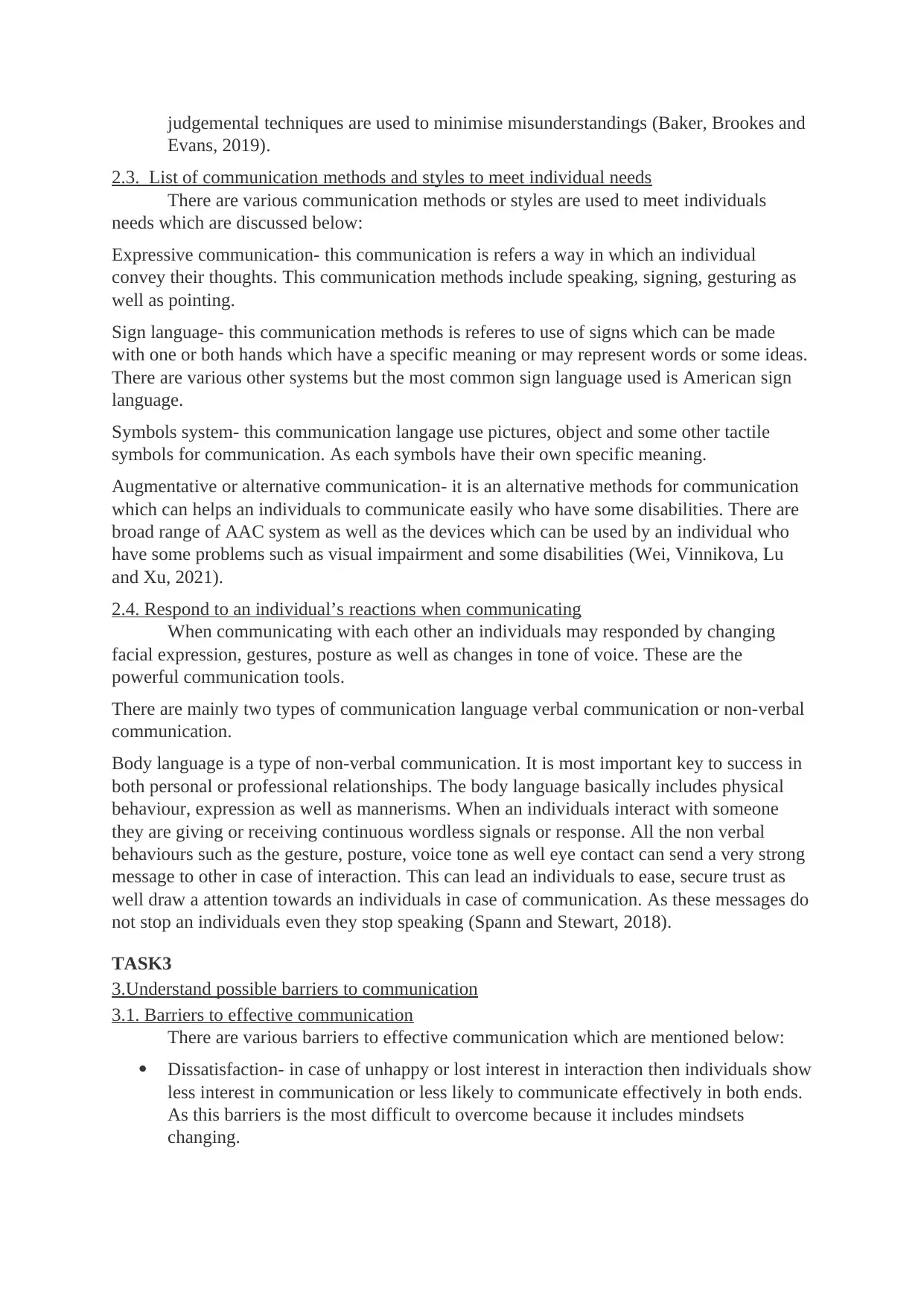
judgemental techniques are used to minimise misunderstandings (Baker, Brookes and
Evans, 2019).
2.3. List of communication methods and styles to meet individual needs
There are various communication methods or styles are used to meet individuals
needs which are discussed below:
Expressive communication- this communication is refers a way in which an individual
convey their thoughts. This communication methods include speaking, signing, gesturing as
well as pointing.
Sign language- this communication methods is referes to use of signs which can be made
with one or both hands which have a specific meaning or may represent words or some ideas.
There are various other systems but the most common sign language used is American sign
language.
Symbols system- this communication langage use pictures, object and some other tactile
symbols for communication. As each symbols have their own specific meaning.
Augmentative or alternative communication- it is an alternative methods for communication
which can helps an individuals to communicate easily who have some disabilities. There are
broad range of AAC system as well as the devices which can be used by an individual who
have some problems such as visual impairment and some disabilities (Wei, Vinnikova, Lu
and Xu, 2021).
2.4. Respond to an individual’s reactions when communicating
When communicating with each other an individuals may responded by changing
facial expression, gestures, posture as well as changes in tone of voice. These are the
powerful communication tools.
There are mainly two types of communication language verbal communication or non-verbal
communication.
Body language is a type of non-verbal communication. It is most important key to success in
both personal or professional relationships. The body language basically includes physical
behaviour, expression as well as mannerisms. When an individuals interact with someone
they are giving or receiving continuous wordless signals or response. All the non verbal
behaviours such as the gesture, posture, voice tone as well eye contact can send a very strong
message to other in case of interaction. This can lead an individuals to ease, secure trust as
well draw a attention towards an individuals in case of communication. As these messages do
not stop an individuals even they stop speaking (Spann and Stewart, 2018).
TASK3
3.Understand possible barriers to communication
3.1. Barriers to effective communication
There are various barriers to effective communication which are mentioned below:
Dissatisfaction- in case of unhappy or lost interest in interaction then individuals show
less interest in communication or less likely to communicate effectively in both ends.
As this barriers is the most difficult to overcome because it includes mindsets
changing.
Evans, 2019).
2.3. List of communication methods and styles to meet individual needs
There are various communication methods or styles are used to meet individuals
needs which are discussed below:
Expressive communication- this communication is refers a way in which an individual
convey their thoughts. This communication methods include speaking, signing, gesturing as
well as pointing.
Sign language- this communication methods is referes to use of signs which can be made
with one or both hands which have a specific meaning or may represent words or some ideas.
There are various other systems but the most common sign language used is American sign
language.
Symbols system- this communication langage use pictures, object and some other tactile
symbols for communication. As each symbols have their own specific meaning.
Augmentative or alternative communication- it is an alternative methods for communication
which can helps an individuals to communicate easily who have some disabilities. There are
broad range of AAC system as well as the devices which can be used by an individual who
have some problems such as visual impairment and some disabilities (Wei, Vinnikova, Lu
and Xu, 2021).
2.4. Respond to an individual’s reactions when communicating
When communicating with each other an individuals may responded by changing
facial expression, gestures, posture as well as changes in tone of voice. These are the
powerful communication tools.
There are mainly two types of communication language verbal communication or non-verbal
communication.
Body language is a type of non-verbal communication. It is most important key to success in
both personal or professional relationships. The body language basically includes physical
behaviour, expression as well as mannerisms. When an individuals interact with someone
they are giving or receiving continuous wordless signals or response. All the non verbal
behaviours such as the gesture, posture, voice tone as well eye contact can send a very strong
message to other in case of interaction. This can lead an individuals to ease, secure trust as
well draw a attention towards an individuals in case of communication. As these messages do
not stop an individuals even they stop speaking (Spann and Stewart, 2018).
TASK3
3.Understand possible barriers to communication
3.1. Barriers to effective communication
There are various barriers to effective communication which are mentioned below:
Dissatisfaction- in case of unhappy or lost interest in interaction then individuals show
less interest in communication or less likely to communicate effectively in both ends.
As this barriers is the most difficult to overcome because it includes mindsets
changing.
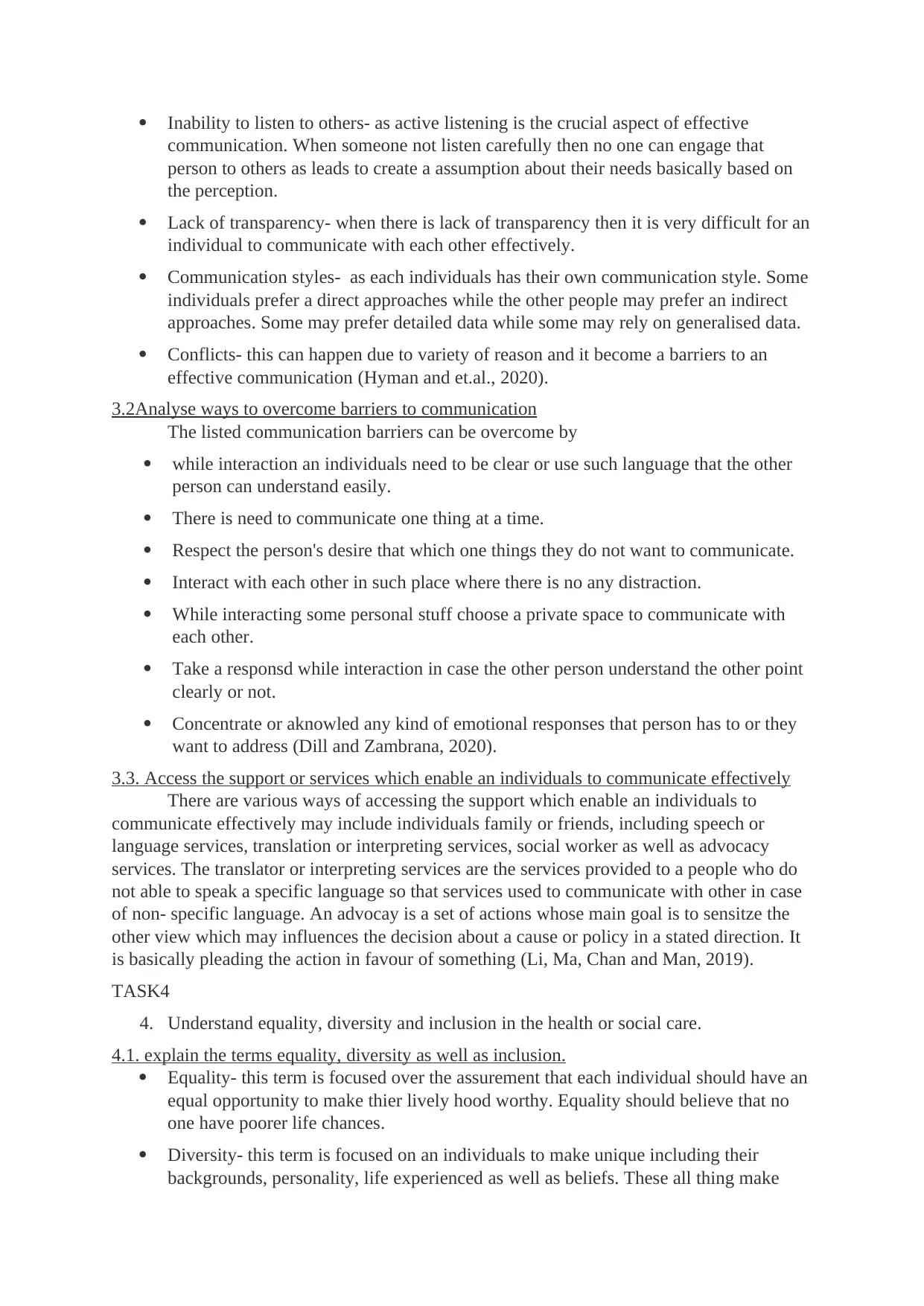
Inability to listen to others- as active listening is the crucial aspect of effective
communication. When someone not listen carefully then no one can engage that
person to others as leads to create a assumption about their needs basically based on
the perception.
Lack of transparency- when there is lack of transparency then it is very difficult for an
individual to communicate with each other effectively.
Communication styles- as each individuals has their own communication style. Some
individuals prefer a direct approaches while the other people may prefer an indirect
approaches. Some may prefer detailed data while some may rely on generalised data.
Conflicts- this can happen due to variety of reason and it become a barriers to an
effective communication (Hyman and et.al., 2020).
3.2Analyse ways to overcome barriers to communication
The listed communication barriers can be overcome by
while interaction an individuals need to be clear or use such language that the other
person can understand easily.
There is need to communicate one thing at a time.
Respect the person's desire that which one things they do not want to communicate.
Interact with each other in such place where there is no any distraction.
While interacting some personal stuff choose a private space to communicate with
each other.
Take a responsd while interaction in case the other person understand the other point
clearly or not.
Concentrate or aknowled any kind of emotional responses that person has to or they
want to address (Dill and Zambrana, 2020).
3.3. Access the support or services which enable an individuals to communicate effectively
There are various ways of accessing the support which enable an individuals to
communicate effectively may include individuals family or friends, including speech or
language services, translation or interpreting services, social worker as well as advocacy
services. The translator or interpreting services are the services provided to a people who do
not able to speak a specific language so that services used to communicate with other in case
of non- specific language. An advocay is a set of actions whose main goal is to sensitze the
other view which may influences the decision about a cause or policy in a stated direction. It
is basically pleading the action in favour of something (Li, Ma, Chan and Man, 2019).
TASK4
4. Understand equality, diversity and inclusion in the health or social care.
4.1. explain the terms equality, diversity as well as inclusion.
Equality- this term is focused over the assurement that each individual should have an
equal opportunity to make thier lively hood worthy. Equality should believe that no
one have poorer life chances.
Diversity- this term is focused on an individuals to make unique including their
backgrounds, personality, life experienced as well as beliefs. These all thing make
communication. When someone not listen carefully then no one can engage that
person to others as leads to create a assumption about their needs basically based on
the perception.
Lack of transparency- when there is lack of transparency then it is very difficult for an
individual to communicate with each other effectively.
Communication styles- as each individuals has their own communication style. Some
individuals prefer a direct approaches while the other people may prefer an indirect
approaches. Some may prefer detailed data while some may rely on generalised data.
Conflicts- this can happen due to variety of reason and it become a barriers to an
effective communication (Hyman and et.al., 2020).
3.2Analyse ways to overcome barriers to communication
The listed communication barriers can be overcome by
while interaction an individuals need to be clear or use such language that the other
person can understand easily.
There is need to communicate one thing at a time.
Respect the person's desire that which one things they do not want to communicate.
Interact with each other in such place where there is no any distraction.
While interacting some personal stuff choose a private space to communicate with
each other.
Take a responsd while interaction in case the other person understand the other point
clearly or not.
Concentrate or aknowled any kind of emotional responses that person has to or they
want to address (Dill and Zambrana, 2020).
3.3. Access the support or services which enable an individuals to communicate effectively
There are various ways of accessing the support which enable an individuals to
communicate effectively may include individuals family or friends, including speech or
language services, translation or interpreting services, social worker as well as advocacy
services. The translator or interpreting services are the services provided to a people who do
not able to speak a specific language so that services used to communicate with other in case
of non- specific language. An advocay is a set of actions whose main goal is to sensitze the
other view which may influences the decision about a cause or policy in a stated direction. It
is basically pleading the action in favour of something (Li, Ma, Chan and Man, 2019).
TASK4
4. Understand equality, diversity and inclusion in the health or social care.
4.1. explain the terms equality, diversity as well as inclusion.
Equality- this term is focused over the assurement that each individual should have an
equal opportunity to make thier lively hood worthy. Equality should believe that no
one have poorer life chances.
Diversity- this term is focused on an individuals to make unique including their
backgrounds, personality, life experienced as well as beliefs. These all thing make
⊘ This is a preview!⊘
Do you want full access?
Subscribe today to unlock all pages.

Trusted by 1+ million students worldwide
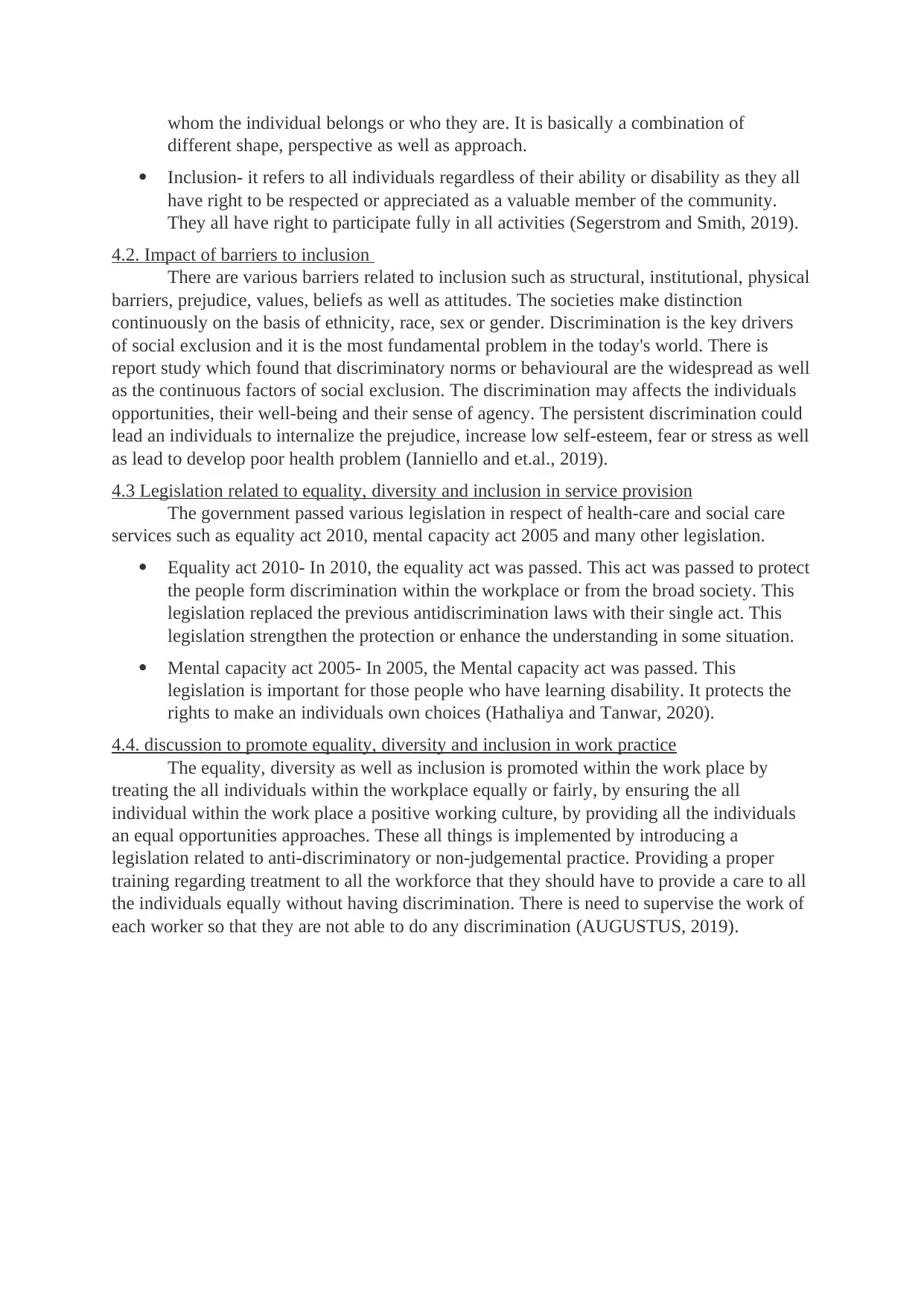
whom the individual belongs or who they are. It is basically a combination of
different shape, perspective as well as approach.
Inclusion- it refers to all individuals regardless of their ability or disability as they all
have right to be respected or appreciated as a valuable member of the community.
They all have right to participate fully in all activities (Segerstrom and Smith, 2019).
4.2. Impact of barriers to inclusion
There are various barriers related to inclusion such as structural, institutional, physical
barriers, prejudice, values, beliefs as well as attitudes. The societies make distinction
continuously on the basis of ethnicity, race, sex or gender. Discrimination is the key drivers
of social exclusion and it is the most fundamental problem in the today's world. There is
report study which found that discriminatory norms or behavioural are the widespread as well
as the continuous factors of social exclusion. The discrimination may affects the individuals
opportunities, their well-being and their sense of agency. The persistent discrimination could
lead an individuals to internalize the prejudice, increase low self-esteem, fear or stress as well
as lead to develop poor health problem (Ianniello and et.al., 2019).
4.3 Legislation related to equality, diversity and inclusion in service provision
The government passed various legislation in respect of health-care and social care
services such as equality act 2010, mental capacity act 2005 and many other legislation.
Equality act 2010- In 2010, the equality act was passed. This act was passed to protect
the people form discrimination within the workplace or from the broad society. This
legislation replaced the previous antidiscrimination laws with their single act. This
legislation strengthen the protection or enhance the understanding in some situation.
Mental capacity act 2005- In 2005, the Mental capacity act was passed. This
legislation is important for those people who have learning disability. It protects the
rights to make an individuals own choices (Hathaliya and Tanwar, 2020).
4.4. discussion to promote equality, diversity and inclusion in work practice
The equality, diversity as well as inclusion is promoted within the work place by
treating the all individuals within the workplace equally or fairly, by ensuring the all
individual within the work place a positive working culture, by providing all the individuals
an equal opportunities approaches. These all things is implemented by introducing a
legislation related to anti-discriminatory or non-judgemental practice. Providing a proper
training regarding treatment to all the workforce that they should have to provide a care to all
the individuals equally without having discrimination. There is need to supervise the work of
each worker so that they are not able to do any discrimination (AUGUSTUS, 2019).
different shape, perspective as well as approach.
Inclusion- it refers to all individuals regardless of their ability or disability as they all
have right to be respected or appreciated as a valuable member of the community.
They all have right to participate fully in all activities (Segerstrom and Smith, 2019).
4.2. Impact of barriers to inclusion
There are various barriers related to inclusion such as structural, institutional, physical
barriers, prejudice, values, beliefs as well as attitudes. The societies make distinction
continuously on the basis of ethnicity, race, sex or gender. Discrimination is the key drivers
of social exclusion and it is the most fundamental problem in the today's world. There is
report study which found that discriminatory norms or behavioural are the widespread as well
as the continuous factors of social exclusion. The discrimination may affects the individuals
opportunities, their well-being and their sense of agency. The persistent discrimination could
lead an individuals to internalize the prejudice, increase low self-esteem, fear or stress as well
as lead to develop poor health problem (Ianniello and et.al., 2019).
4.3 Legislation related to equality, diversity and inclusion in service provision
The government passed various legislation in respect of health-care and social care
services such as equality act 2010, mental capacity act 2005 and many other legislation.
Equality act 2010- In 2010, the equality act was passed. This act was passed to protect
the people form discrimination within the workplace or from the broad society. This
legislation replaced the previous antidiscrimination laws with their single act. This
legislation strengthen the protection or enhance the understanding in some situation.
Mental capacity act 2005- In 2005, the Mental capacity act was passed. This
legislation is important for those people who have learning disability. It protects the
rights to make an individuals own choices (Hathaliya and Tanwar, 2020).
4.4. discussion to promote equality, diversity and inclusion in work practice
The equality, diversity as well as inclusion is promoted within the work place by
treating the all individuals within the workplace equally or fairly, by ensuring the all
individual within the work place a positive working culture, by providing all the individuals
an equal opportunities approaches. These all things is implemented by introducing a
legislation related to anti-discriminatory or non-judgemental practice. Providing a proper
training regarding treatment to all the workforce that they should have to provide a care to all
the individuals equally without having discrimination. There is need to supervise the work of
each worker so that they are not able to do any discrimination (AUGUSTUS, 2019).
Paraphrase This Document
Need a fresh take? Get an instant paraphrase of this document with our AI Paraphraser
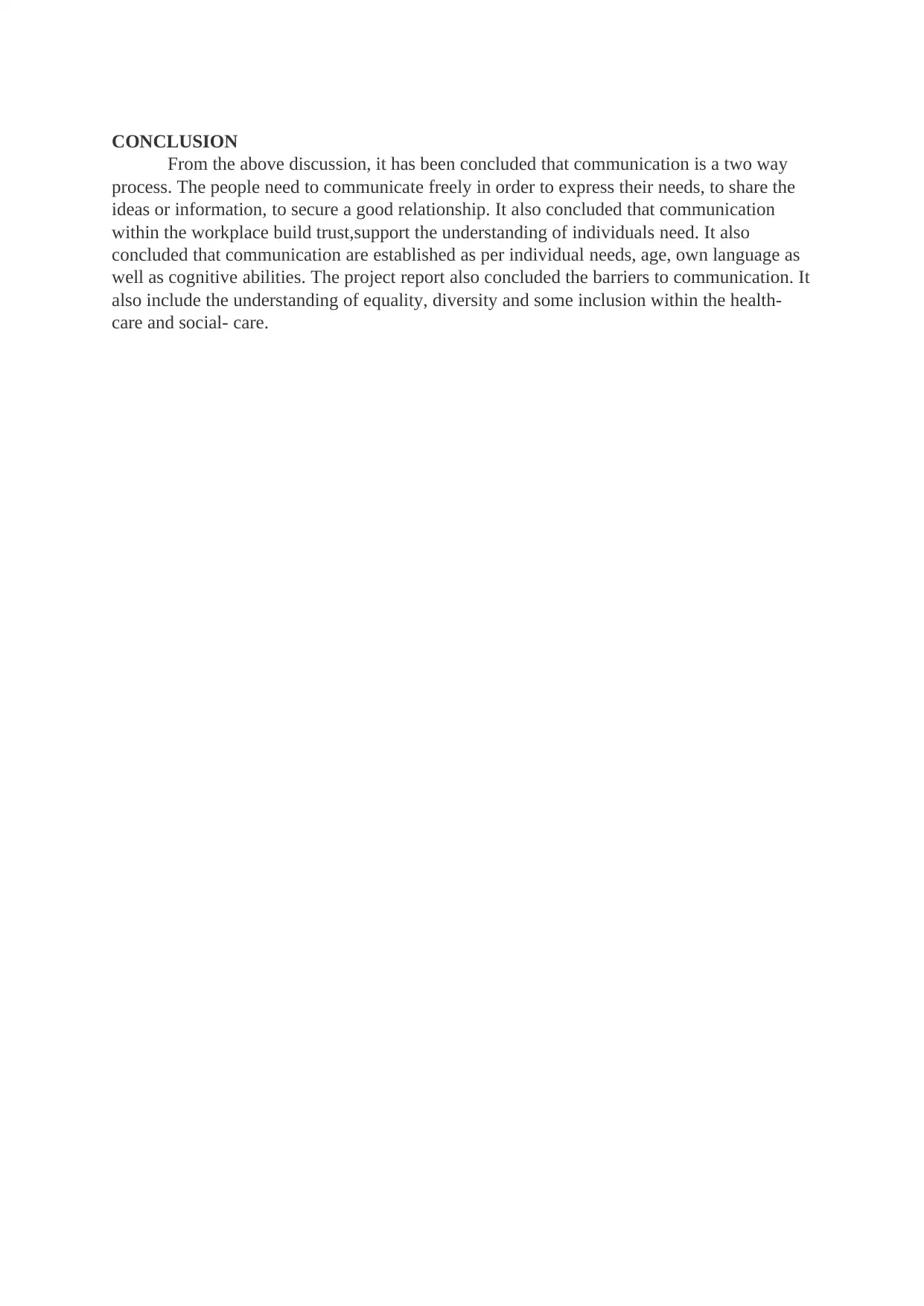
CONCLUSION
From the above discussion, it has been concluded that communication is a two way
process. The people need to communicate freely in order to express their needs, to share the
ideas or information, to secure a good relationship. It also concluded that communication
within the workplace build trust,support the understanding of individuals need. It also
concluded that communication are established as per individual needs, age, own language as
well as cognitive abilities. The project report also concluded the barriers to communication. It
also include the understanding of equality, diversity and some inclusion within the health-
care and social- care.
From the above discussion, it has been concluded that communication is a two way
process. The people need to communicate freely in order to express their needs, to share the
ideas or information, to secure a good relationship. It also concluded that communication
within the workplace build trust,support the understanding of individuals need. It also
concluded that communication are established as per individual needs, age, own language as
well as cognitive abilities. The project report also concluded the barriers to communication. It
also include the understanding of equality, diversity and some inclusion within the health-
care and social- care.

⊘ This is a preview!⊘
Do you want full access?
Subscribe today to unlock all pages.

Trusted by 1+ million students worldwide
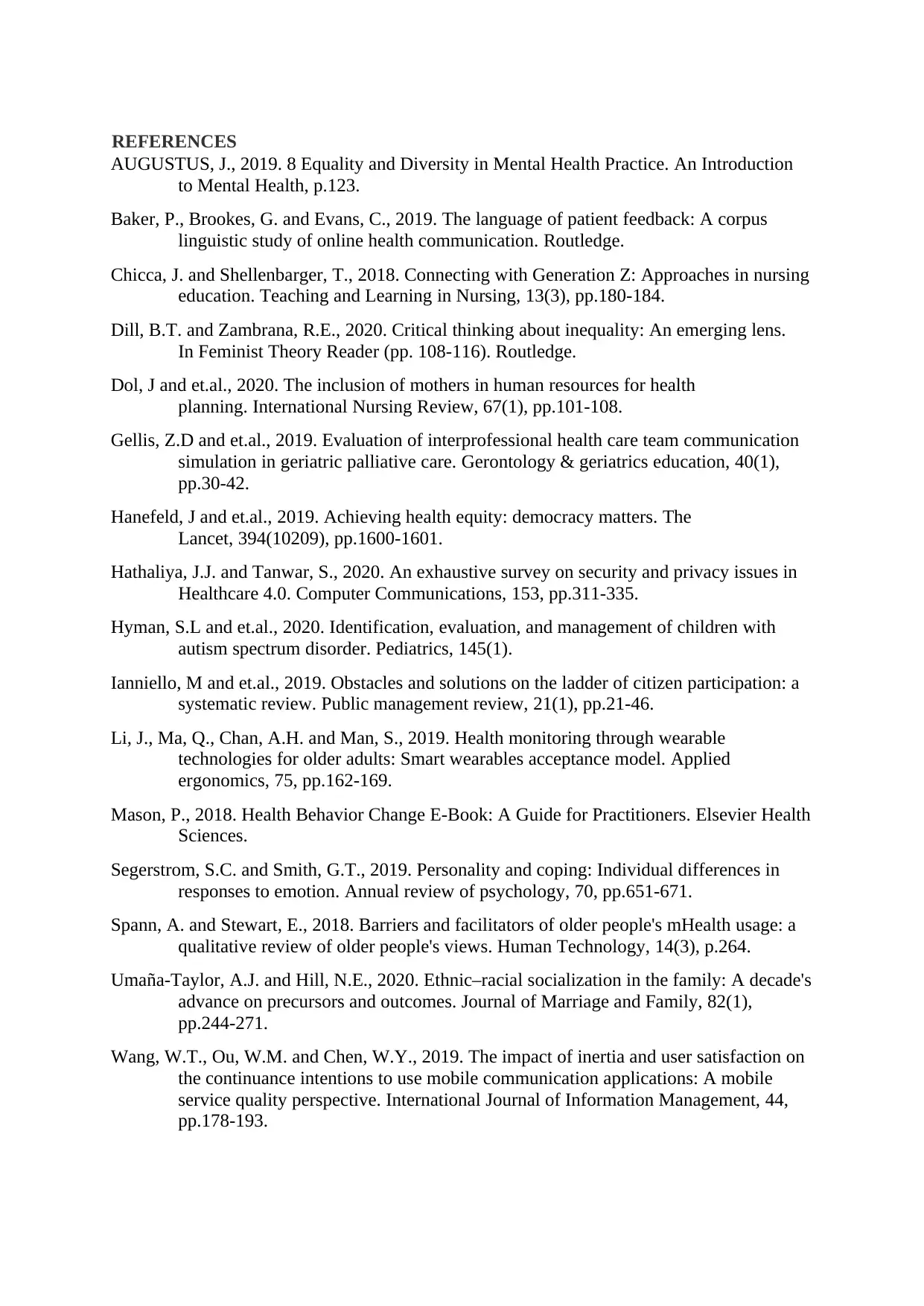
REFERENCES
AUGUSTUS, J., 2019. 8 Equality and Diversity in Mental Health Practice. An Introduction
to Mental Health, p.123.
Baker, P., Brookes, G. and Evans, C., 2019. The language of patient feedback: A corpus
linguistic study of online health communication. Routledge.
Chicca, J. and Shellenbarger, T., 2018. Connecting with Generation Z: Approaches in nursing
education. Teaching and Learning in Nursing, 13(3), pp.180-184.
Dill, B.T. and Zambrana, R.E., 2020. Critical thinking about inequality: An emerging lens.
In Feminist Theory Reader (pp. 108-116). Routledge.
Dol, J and et.al., 2020. The inclusion of mothers in human resources for health
planning. International Nursing Review, 67(1), pp.101-108.
Gellis, Z.D and et.al., 2019. Evaluation of interprofessional health care team communication
simulation in geriatric palliative care. Gerontology & geriatrics education, 40(1),
pp.30-42.
Hanefeld, J and et.al., 2019. Achieving health equity: democracy matters. The
Lancet, 394(10209), pp.1600-1601.
Hathaliya, J.J. and Tanwar, S., 2020. An exhaustive survey on security and privacy issues in
Healthcare 4.0. Computer Communications, 153, pp.311-335.
Hyman, S.L and et.al., 2020. Identification, evaluation, and management of children with
autism spectrum disorder. Pediatrics, 145(1).
Ianniello, M and et.al., 2019. Obstacles and solutions on the ladder of citizen participation: a
systematic review. Public management review, 21(1), pp.21-46.
Li, J., Ma, Q., Chan, A.H. and Man, S., 2019. Health monitoring through wearable
technologies for older adults: Smart wearables acceptance model. Applied
ergonomics, 75, pp.162-169.
Mason, P., 2018. Health Behavior Change E-Book: A Guide for Practitioners. Elsevier Health
Sciences.
Segerstrom, S.C. and Smith, G.T., 2019. Personality and coping: Individual differences in
responses to emotion. Annual review of psychology, 70, pp.651-671.
Spann, A. and Stewart, E., 2018. Barriers and facilitators of older people's mHealth usage: a
qualitative review of older people's views. Human Technology, 14(3), p.264.
Umaña‐Taylor, A.J. and Hill, N.E., 2020. Ethnic–racial socialization in the family: A decade's
advance on precursors and outcomes. Journal of Marriage and Family, 82(1),
pp.244-271.
Wang, W.T., Ou, W.M. and Chen, W.Y., 2019. The impact of inertia and user satisfaction on
the continuance intentions to use mobile communication applications: A mobile
service quality perspective. International Journal of Information Management, 44,
pp.178-193.
AUGUSTUS, J., 2019. 8 Equality and Diversity in Mental Health Practice. An Introduction
to Mental Health, p.123.
Baker, P., Brookes, G. and Evans, C., 2019. The language of patient feedback: A corpus
linguistic study of online health communication. Routledge.
Chicca, J. and Shellenbarger, T., 2018. Connecting with Generation Z: Approaches in nursing
education. Teaching and Learning in Nursing, 13(3), pp.180-184.
Dill, B.T. and Zambrana, R.E., 2020. Critical thinking about inequality: An emerging lens.
In Feminist Theory Reader (pp. 108-116). Routledge.
Dol, J and et.al., 2020. The inclusion of mothers in human resources for health
planning. International Nursing Review, 67(1), pp.101-108.
Gellis, Z.D and et.al., 2019. Evaluation of interprofessional health care team communication
simulation in geriatric palliative care. Gerontology & geriatrics education, 40(1),
pp.30-42.
Hanefeld, J and et.al., 2019. Achieving health equity: democracy matters. The
Lancet, 394(10209), pp.1600-1601.
Hathaliya, J.J. and Tanwar, S., 2020. An exhaustive survey on security and privacy issues in
Healthcare 4.0. Computer Communications, 153, pp.311-335.
Hyman, S.L and et.al., 2020. Identification, evaluation, and management of children with
autism spectrum disorder. Pediatrics, 145(1).
Ianniello, M and et.al., 2019. Obstacles and solutions on the ladder of citizen participation: a
systematic review. Public management review, 21(1), pp.21-46.
Li, J., Ma, Q., Chan, A.H. and Man, S., 2019. Health monitoring through wearable
technologies for older adults: Smart wearables acceptance model. Applied
ergonomics, 75, pp.162-169.
Mason, P., 2018. Health Behavior Change E-Book: A Guide for Practitioners. Elsevier Health
Sciences.
Segerstrom, S.C. and Smith, G.T., 2019. Personality and coping: Individual differences in
responses to emotion. Annual review of psychology, 70, pp.651-671.
Spann, A. and Stewart, E., 2018. Barriers and facilitators of older people's mHealth usage: a
qualitative review of older people's views. Human Technology, 14(3), p.264.
Umaña‐Taylor, A.J. and Hill, N.E., 2020. Ethnic–racial socialization in the family: A decade's
advance on precursors and outcomes. Journal of Marriage and Family, 82(1),
pp.244-271.
Wang, W.T., Ou, W.M. and Chen, W.Y., 2019. The impact of inertia and user satisfaction on
the continuance intentions to use mobile communication applications: A mobile
service quality perspective. International Journal of Information Management, 44,
pp.178-193.
Paraphrase This Document
Need a fresh take? Get an instant paraphrase of this document with our AI Paraphraser
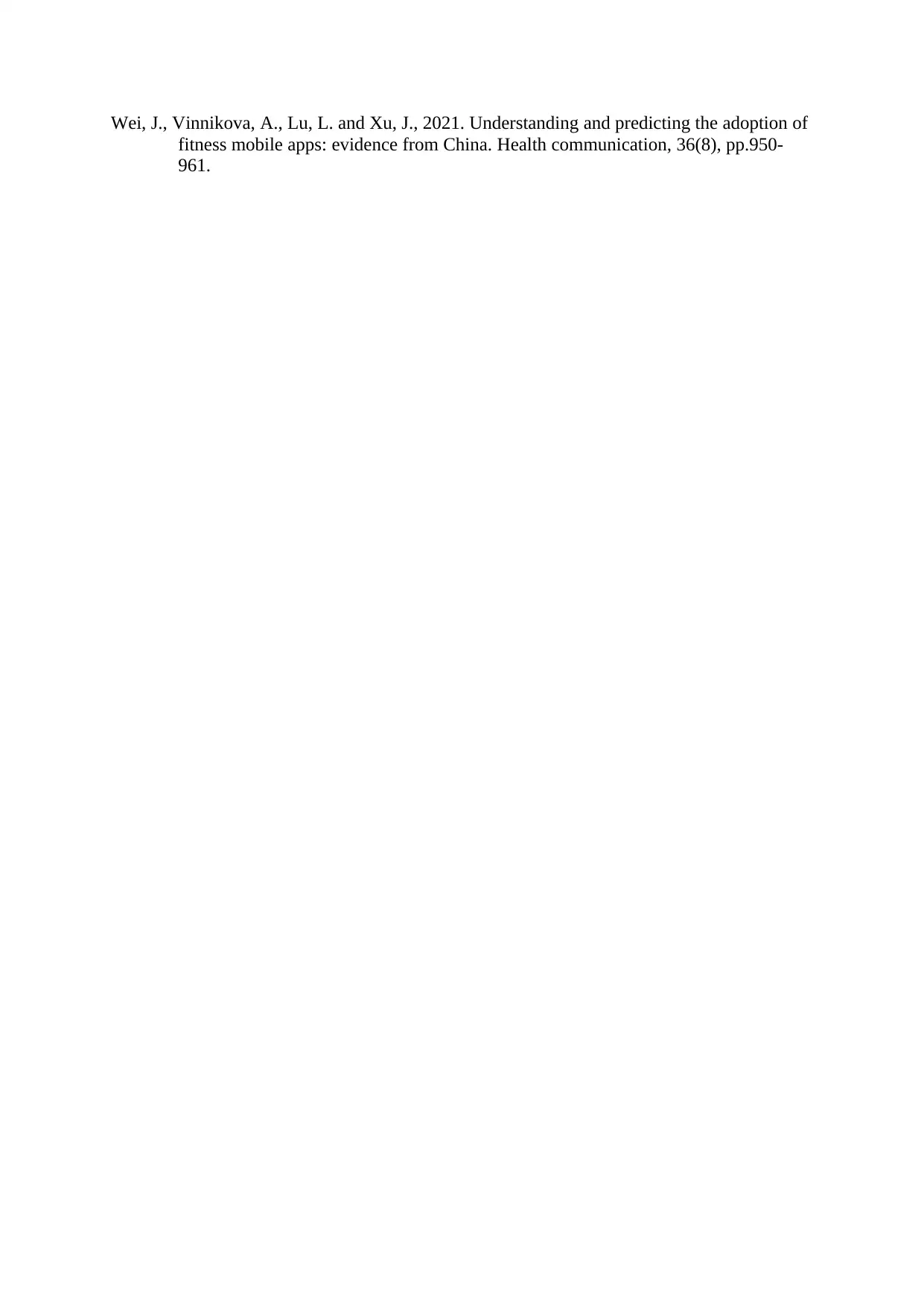
Wei, J., Vinnikova, A., Lu, L. and Xu, J., 2021. Understanding and predicting the adoption of
fitness mobile apps: evidence from China. Health communication, 36(8), pp.950-
961.
fitness mobile apps: evidence from China. Health communication, 36(8), pp.950-
961.
1 out of 11
Related Documents
Your All-in-One AI-Powered Toolkit for Academic Success.
+13062052269
info@desklib.com
Available 24*7 on WhatsApp / Email
![[object Object]](/_next/static/media/star-bottom.7253800d.svg)
Unlock your academic potential
Copyright © 2020–2025 A2Z Services. All Rights Reserved. Developed and managed by ZUCOL.




